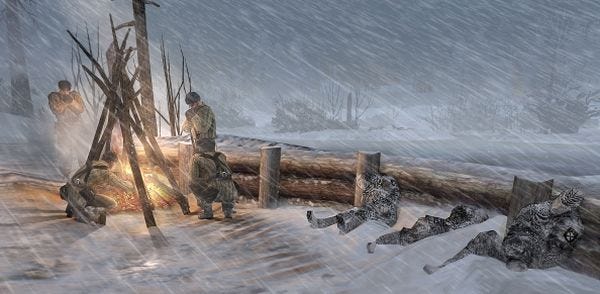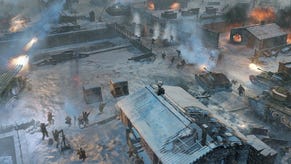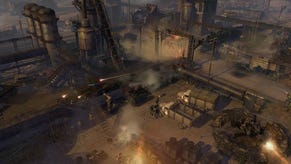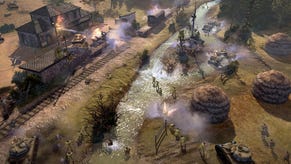Eyes On: Company Of Heroes 2's Cold Front
The Cold War
We sent Craig Pearson out to brave the icy storms of Company Of Heroes 2. Could he weather the assignment? Or would he find it a cool breeze? Snow problem, he said... He was shown the cold weather in the game, see, and quite what an impact it has on how you play. While he was there, Craig spoke to the game's director, Quinn Duffy, and lead animator, Brett Pascal, about the difficulties of portraying snow, the methods behind creating immersion, and dynamic ice.
I fail at a lot of strategy games, but the game I fail the least at is Company Of Heroes. I think it's because it's slower and less abstract. Intensity and authenticity are favoured over speed and complexity. I can figure out how to do things on the battleground, and without the added pressure of having to deal with a base that built a better soldier or recording my mouse clicks in a diary, CoH clicked. I felt that little 'snick' happen again while watching THQ's recent Company of Heroes 2 presentation in Dublin: I could probably handle this.
"Company of Heroes can be very intense, but it's not an APM type of game," Game Director Quinn Duffy agrees. "You have people that pride themselves on having 300APM, I don't know what they're up to now, I can play Company of Heroes with just the taskbar and the mouse. You can make very deliberate actions and decision, and you don't need to make any micro-control that you get in other strategy games."
The sequel is a familiar friend, even after all this time and new tech: a WW2 set strategy game where the camera is free, but still tight in on the action. The presentation begins focussed so closely on a Russian squad that you can see them rubbing their hands together to keep the cold at bay. I note that you can see five fingers on each hand. They start to walk cagily through the knee-deep snow. The game is set on the Eastern Front, a tricky scenario to adequately capture. The cold killed more than the fighting: it's as deadly as a well-aimed bullet, and its inclusion is the reason it's taken so long for the sequel to arrive.
"We couldn't do snow," explains Duffy. You could just paint it white, but we wanted to try and connect those things to the gameplay. We've got layers of snow. It's not just a texture, it has gameplay impact. We've got deep snow, you can see troops leaving their footprints, and they actually labour through it. So deep snow isn't everywhere, but it's also unavoidable. Being slowed down increases your exposure."
On the screen the troops are doing an odd, open-legged walk through the snow. It's doing more than encumbering them: to the right is a temperature guage, and when it bottoms out the troops start succumbing to the winter. One stops and curls up in the snow, dead before a gun is fired. Is this really a strategy game?
Duffy points out, "We talk about authenticity, it's not about getting every bolt right in a tank or being accurate to a degree. It's about tone and experience. We don't have the simulation depth of a super-hardcore combat game, but what we offer is immersion. In Company of Heroes, when we set a goal of capturing the realism, a lot of it starts with presentation. And then you have figure out how to build a game to support that. So we have this cool gameplay element, how do we build the visuals to support that, that don't take us into a level of abstraction?"
Lead Animator Brett Pascal chips in: "The presentation can bridge the gap. We've got a good gap between the facts and occurrences of the war and the realistic nature of what the combat was, and putting an entertaining skin on it as well."
So while you can die under the frosty horror of the minus 40 degree Russian winter, you can fight it off was well. The cold has to be a defeatable adversary. Cover provides protection from a bullet as well as a pocket of warmth to allow the foot soldiers to cuddle up. There are firelighters in the squad that can set up a recuperative little hollow of heat. I'm fascinated by the odd dynamic: the squad are hunkered down, trying to keep warm while a few feet away a tank starts to fire; they're cowering, not from the fight, but from the cold. It's scarier than the Third Reich.
"The winter stopped the Germans from taking Moscow", Pascal says. "You start with that."
So there's pervasive permafrost to engage, as well as the occasional blizzard that will add more snow. Under a blizzard your troops will freeze faster, and your air-strikes can't operate. Cover and buildings will help mitigate the effects, as will vehicles. But those pose their own challenges against the weather. Augmenting the squad's clumsy trudging are people carriers and tanks. Tanks, so often the solution to all life's problems, suffer from the tracks losing traction across ice, but their weight poses bigger problems. Find a frozen river and there's no guarantee it'll support the tank's tonnage, but daring commanders might see the opportunity, as Duffy points out. "It's a dangerous surface. We all know how fragile ice can be. It's also a life-saving surface. During the siege of Leningrad, when they brought trucks across the lake, that was one of the only ways to supply the city. So for us it's a barrier, but it also allows access. Conditionally, it's slippery, it's dangerous."
On the ice, the tanks leave a trail of cracks behind, but it remains solid until a huge blast from off screen rocks the battle. The tanks vanish into the exposed water, a smiling Duffy points out, "Ice is a fully destructible layer. It's also a very dynamic layer, so this area of the map that's destroyed now will eventually refreeze. It can be destroyed and refreeze again, so players can adjust how they move around."
I imagine scenarios where you stifle the opposition by trollishly breaking ice ahead of their troops. But to do that you have to see them, and CoH2 has that covered as well. Everything is affected by the cold, but the obstacles aren't just based on the stuff of snowmen. Under that chilly layer is stodgy Russian architecture. The landscape that the snow drifts over has tactical implications. The smallest tweak of these is allowing the players to vault over fences that dot the world, because they're nothing but lines on a map anyway. But the biggest is True Sight. It's a dynamic line of sight system that properly takes into account what can be seen: there's no vision cones, just what you can see, and it's altered as the ground shifts. If a house is crumbled to the ground, it no longer provides cover. If a tank is stopped dead in the middle of a street, the squad can use it to hide their movement. The light shadow that True Sight drapes is a constantly morphing, lumpy, tactical blanket that lets tanks and squads to leap out of cover like a cat in a horror movie. It's jumpy, as the demo shows a village becoming a bogged down battlefield of counter-manoeuvres around appearing and disappearing enemies. Quickly the Russians are left with a single tank and an overbearing influx of Gemans.
It's a trap: Duffy is luring the Reich, clumping them together for a show of Russian firepower. Elsewhere on the map sits a Katyusha, an artillery rocket launcher. Several truckloads of artillery are launched at the Germans, who're unfortunately placed over a frozen river. The barrage is ferocious: before the tanks melt into the frozen river, they're swallowed by the flames bursting from the missiles. When it clears, all that's left is a churning river of ice.
Yeah, it's pretty cool.












